Benelux
Benelux Union |
||||
|---|---|---|---|---|
|
||||
Countries |
||||
.svg.png) |
||||
| Administrative centre and largest agglomeration | Brussels 50°51′N 4°21′E / 50.850°N 4.350°E | |||
| Official languages | Dutch, French[1] | |||
| Other official languages of contracting states |
German, Luxembourgish | |||
| Type | Politico‑economic union | |||
| Member states | ||||
| Legislature | Parliament | |||
| Establishment | ||||
| • | Customs union treaty signed | 5 September 1944[2] | ||
| • | Customs union in effect | 1 January 1948[2] | ||
| • | Renewal signed | 17 June 2008 | ||
| • | Renewal in effect | 1 January 2010 | ||
| Area | ||||
| • | Total | 76,657 km2 29,597 sq mi |
||
| Population | ||||
| • | estimate | 29.1 million | ||
| • | Density | 380/km2 984/sq mi |
||
| GDP (PPP) | 2013 estimate | |||
| • | Total | $1.379 trillion[3] | ||
| • | Per capita | $48,359 | ||
| Currency | Euro (EUR) | |||
| Time zone | CET (UTC+1) | |||
| • | Summer (DST) | CEST (UTC+2) | ||
| Drives on the | right | |||
| Website www |
||||
The Benelux Union (Dutch: Benelux Unie;[4] French: Union Benelux)[5] is a politico-economic union of three neighbouring states in western Europe: Belgium, the Netherlands, and Luxembourg.[6]
The name Benelux is formed from joining the first two or three letters of each country's name – Belgium Netherlands Luxembourg – and was first used to name the customs agreement that initiated the union (signed in 1944).[7] It is now used more generally to refer to the geographic, economic and cultural grouping of the three countries.
In 1951, these countries joined West Germany, France, and Italy to form the European Coal and Steel Community, a predecessor of the European Economic Community (EEC) and today's European Union (EU).
The main institutions of the Union are the Committee of Ministers, the Benelux Parliament, the Council of the Union and the Secretariat-General, while the Benelux Organization for Intellectual Property and the Benelux Court of Justice cover the same territory but are not part of the Union.
The Benelux General Secretariat is located in Brussels. It is the central administrative pillar of the Benelux Union. It handles the secretariat of the Committee of Ministers, the Council of Economic Union and the various committees and working parties. Moreover, it ensures the registry of the Benelux Court of Justice.
Politics
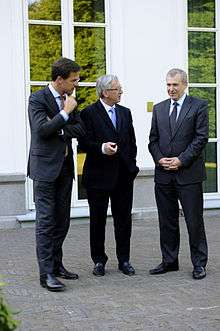
A Benelux Parliament (originally referred to as an "Interparliamentary Consultative Council") was created in 1955. This parliamentary assembly is composed of 21 members of the Dutch parliament, 21 members of the Belgian national and regional parliaments, and 7 members of the Luxembourg parliament.
In 1944, exiled representatives of the three countries signed the London Customs Convention, the treaty that established the Benelux Customs Union. Ratified in 1947, the treaty was in force from 1948 until it was superseded by the Benelux Economic Union. The treaty establishing the Benelux Economic Union (Benelux Economische Unie/Union Économique Benelux) was signed on 3 February 1958 in The Hague and came into force on 1 November 1960 to promote the free movement of workers, capital, services, and goods in the region. Under the Treaty the Union implies the co-operation of economic, financial and social policies.
Law
The Benelux Union involves an intergovernmental co-operation. Decisions are taken unanimously.
The unification of the law of the three Benelux countries is mainly achieved by regulations of its Committee of Ministers, that only bind the three states, but are not directly applicable in their internal legal orders. They only become legally valid after having been incorporated into national law, with the exception of Belgium. The Belgian constitutional court decided in 1971 that any self-executing treaties have priority over laws by the Belgian parliament.
The Treaty establishing the Benelux Union has provided the Committee of Ministers with the following legal instruments: decisions, conventions, recommendations and directives.
The Committee of Ministers can promulgate decisions in the fields for which it has competence - those fields are explicitly set down in the Union Treaty or the additional conventions. When the Committee of Ministers adopts a decision, it immediately becomes binding on the three governments. For a decision to be also applicable to the citizen, it must be transposed into national law.
The Union Treaty is not exhaustive. For this reason, Article 19 of the Treaty provides that the Committee of Ministers may conclude additional conventions. These therefore constitute extensions of the Union Treaty. They are submitted to the national parliaments for approval in keeping with the ratification procedure applied in each of the Member States. Thus there are a large number of Benelux conventions in a wide range of subject matters.[8]
In 1965, the treaty establishing a Benelux Court of Justice was signed. It entered into force in 1974.[9] The Court, composed of judges from the highest courts of the three States, has to guarantee the uniform interpretation of common legal rules. This international judicial institution is located in Brussels.
The Benelux is particularly active in the field of intellectual property. The three countries established a Benelux Trademarks Office and a Benelux Designs Office, both situated in The Hague. In 2005, they concluded a treaty establishing a Benelux Organization for Intellectual Property which replaced both offices upon its entry into force on 1 September 2006. This Organization is the official body for the registration of trademarks and designs in the Benelux. In addition, it offers the possibility to formally record the existence of ideas, concepts, designs, prototypes and the like.[10]
List
Countries
Associated territories
Sports
In 2000, Belgium and the Netherlands jointly hosted the UEFA European Championship. In June 2007, representatives of the three countries announced they would bid, as a single political entity, for the 2018 FIFA World Cup.[48]
Renewal of the agreement
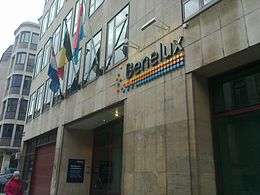
The Treaty between the Benelux countries establishing the Benelux Economic Union was limited to a period of 50 years. During the following years, and even more so after the creation of the European Union, the Benelux cooperation focused on developing other fields of activity within a constantly changing international context.
At the end of the 50 years, the governments of the three Benelux countries decided to renew the agreement, taking into account the new aspects of the Benelux-cooperation – such as security – and the new federal government structure of Belgium. The original establishing treaty, set to expire in 2010, was replaced by a new legal framework (called the Treaty revising the Treaty establishing the Benelux Economic Union), which was signed on 17 June 2008.
The new treaty has no set time limit and the name of the Benelux Economic Union changed to Benelux Union to reflect the broad scope on the union.[49] The main objectives of the treaty are the continuation and enlargement of the cooperation between the three member states within a larger European context. The renewed treaty explicitly foresees the possibility that the Benelux countries will cooperate with other European member States or with regional cooperation structures. The new Benelux cooperation focuses on three main topics: internal market and economic union, sustainability, justice and internal affairs. The number of structures in the renewed Treaty has been reduced and thus simplified. Five Benelux institutions remain: the Benelux Committee of Ministers, the Benelux Council, the Benelux Parliament, the Benelux Court of Justice, the Benelux Secretariat General. Beside these five institutions, the Benelux Organization for Intellectual Property is also present in this Treaty.
See also
References
- ↑ "Révision portant sur le traité de 1958" (PDF) (in French). 2008.
Article 38 : le français et le néerlandais sont les langues officielles des institutions de l'Union Benelux
- 1 2 Peaslee, Amos Jenkins; Xydis, Dorothy Peaslee (1974). International governmental organizations. BRILL. p. 165. ISBN 978-90-247-1601-2. Retrieved 4 September 2011.
- ↑ International Monetary Fund Statistics
- ↑ "Over de Benelux" (in Dutch). Benelux. Retrieved 2015-02-09.
Dit alles onder een nieuwe naam: de Benelux Unie.
- ↑ "A propos du Benelux" (in French). Benelux. Retrieved 2015-02-09.
Le 17 juin 2008, un nouveau Traité Benelux était signé. Désormais, la coopération va se concentrer sur trois thèmes-clés: le marché intérieur & l’union économique, le développement durable et la justice & les affaires intérieures et tout ceci sous un nouveau nom:l’Union Benelux.
- ↑ "Benelux Treaty of Economic Union - Belgium-Luxembourg-Netherlands [1958]".
- ↑ Revue de l'Institut International de Statistique (1947) Vol. 15, No. 1/4, page 43. However, according to The Economist, it was coined in August 1946 by that newspaper's correspondent in Belgium ("Going Dutch". The Economist. 3 May 2008. Retrieved 6 September 2012.).
- ↑ "Benelux in a nutshell". General Secretariat of the Benelux. Archived from the original on 18 January 2008. Retrieved 3 February 2008.
- ↑ "Algemene voorstelling van het Benelux-Gerechtshof". Benelux-Gerechtshof. Retrieved 2016-05-10.
- ↑ Archived 4 June 2015 at the Wayback Machine.
- 1 2 3 4 5 6 7 8 9 10 11 "Europe :: Belgium". CIA The World Factbook. Archived from the original on 10 July 2016.
- 1 2 3 4 5 6 7 8 "Europe :: Netherlands". CIA The World Factbook.
- 1 2 3 4 5 6 7 8 9 10 11 12 13 "Europe :: Luxembourg". CIA The World Factbook.
- ↑ "The World Factbook — Central Intelligence Agency".
- ↑ De Belgische Stadsgewesten 2001 Archived 29 October 2008 at the Wayback Machine., Sarah Luyten, Etienne Van Hecke, Instituut voor Sociale en Economische Geografie, K. U.Leuven
- ↑ "Urbanaudit.org".
- ↑ "Urbanaudit.org".
- ↑ "Urbanaudit.org".
- ↑ "Urbanaudit.org".
- ↑ "Urbanaudit.org".
- ↑ Statistics Netherlands.
- ↑ Eurobarometer 393: Discrimination in the EU in 2012 (pdf). European Commission. pp. 233–234. Retrieved 29 December 2015.
- ↑ Schmeets, Hans; Mensvoort, Carly van (2015). Religieuze Betrokkenheid van Bevolkerungsgroepen 2010-2014, Centraalbureau foor de Statistiek
- ↑ "Discrimination in the EU in 2012 – Special Eurobarometer 393 (The question asked was "Do you consider yourself to be...?")" (PDF). European Commission. Retrieved 2 February 2016.
- 1 2 3 4 5 6 7 "World Economic Outlook Database". International Monetary Fund. April 2016.
- 1 2 3 4 5 6 7 "GDP (current US$)" (PDF). World Development Indicators. World Bank. Retrieved 2 July 2015.
- 1 2 3 4 5 6 7 "GDP and its breakdown at current prices in US Dollars". United Nations Statistics Division. December 2015.
- 1 2 3 4 5 6 7 "GDP (Official Exchange Rate)". The World Factbook. Central Intelligence Agency. Retrieved 4 June 2015.
- 1 2 3 4 5 6 7 Some data refers to IMF staff estimates but some are actual figures for the year 2015, made in April 2016. World Economic Outlook Database-April 2016, International Monetary Fund. Accessed on 12 April 2016.
- 1 2 3 4 5 6 7 Data refer mostly to the year 2014. (selecting all countries, GDP per capita (current US$), , World Bank. Accessed on 9 July 2015.
- 1 2 3 4 5 6 7 National Accounts Main Aggregates Database, December 2014, (Select all countries, "GDP, Per Capita GDP - US Dollars", and 2014 to generate table), United Nations Statistics Division. Accessed on 4 Jan 2016.
- 1 2 3 4 5 6 7 "Report for Selected Country Groups and Subjects (PPP valuation of country GDP)". IMF. Retrieved June 13, 2016.
- 1 2 3 4 5 6 7 Data (July 2, 2015). ""Gross domestic product 2014, PPP", World Bank, accessed on 2 July 2015" (PDF). Data.worldbank.org. Retrieved July 2, 2015.; European Union calculated by sum of individual countries.
- 1 2 3 4 5 6 7 "The World Factbook — Central Intelligence Agency".
- 1 2 3 4 5 6 World Economic Outlook Database, April 2016, International Monetary Fund. Database updated on 12 April 2016. Accessed on 14 April 2016.
- 1 2 3 4 5 6 "GDP per capita, PPP (current international $)", World Development Indicators database, World Bank. Database updated on 11 April 2016. Accessed on 14 April 2016.
- 1 2 3 4 5 6 GDP - per capita (PPP), The World Factbook, Central Intelligence Agency. Accessed on 7 March 2014.
- 1 2 3 4 5 6 7 "The World Factbook — Central Intelligence Agency".
- 1 2 3 4 5 6 7 http://www.imf.org/external/pubs/ft/weo/2016/01/pdf/text.pdf
- ↑ In the Caribbean parts of the Netherlands, namely Saba, Sint Eustatius and Bonaire.
- ↑ IISS 2014, pp. 77-79
- ↑ IISS 2014, pp. 121-123
- ↑ IISS 2014, p. 117
- 1 2 3 "COUNTRY COMPARISON :: LABOR FORCE". cia.gov. Retrieved 4 August 2014.
- 1 2 3 4 5 6 7 8 9 10 11 12 13 14 15 16 "Central America and Caribbean :: Aruba". CIA The World Factbook.
- 1 2 3 4 5 6 7 8 9 10 11 12 13 14 "Central America and Caribbean :: Curacao". CIA The World Factbook.
- 1 2 3 4 5 6 7 8 9 10 11 12 13 14 15 "Central America and Caribbean :: Sint Maarten". CIA The World Factbook.
- ↑ "Benelux countries launch 2018 World Cup bid". ESPN. 27 June 2007. Retrieved 29 October 2007.
- ↑ Benelux union Archived 1 October 2009 at the Wayback Machine.
External links
| Wikimedia Commons has media related to Benelux. |
| Wikivoyage has a travel guide for Benelux. |
- Official sites
- Benelux official site (in French)
- Benelux Parliament
- Benelux Court of Justice
- Benelux Office for Intellectual Property
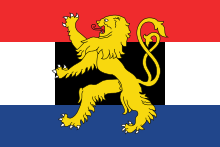
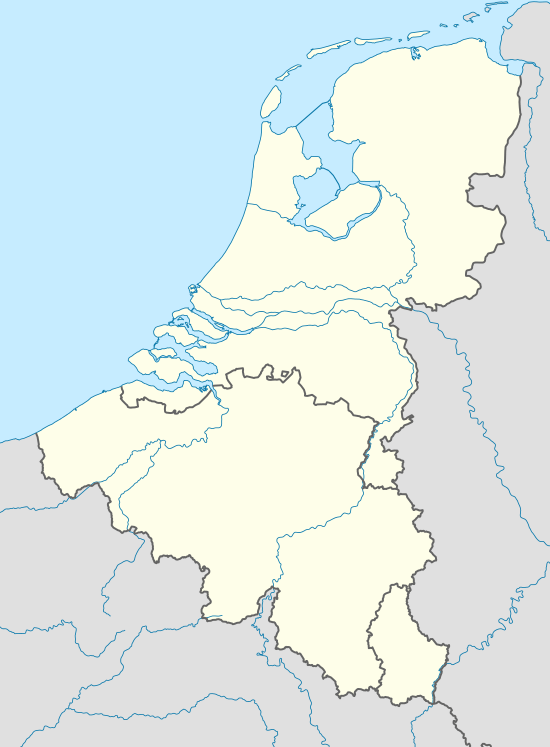
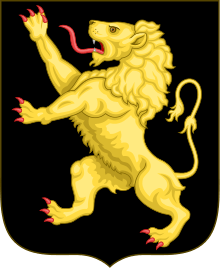
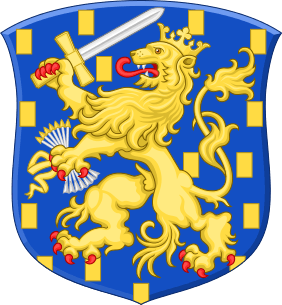
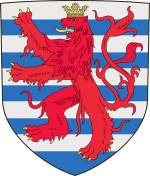


.svg.png)